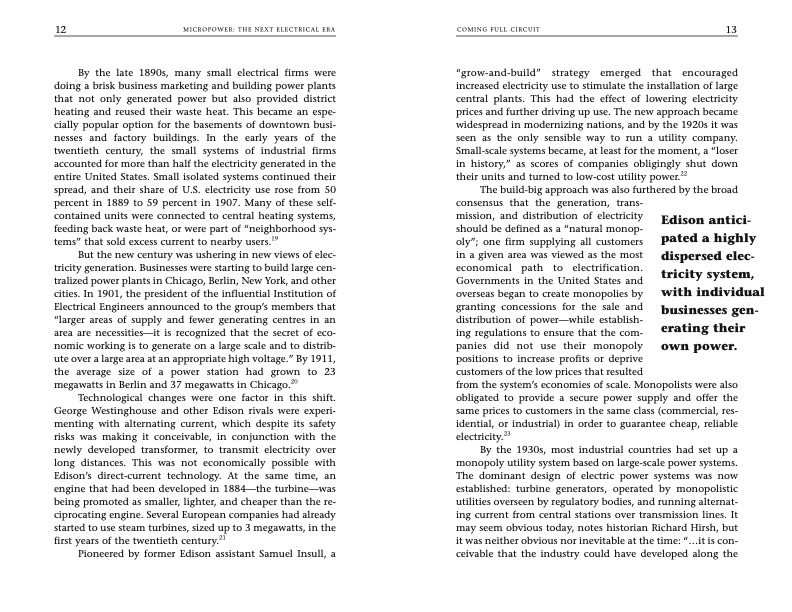
PDF Publication Title:
Text from PDF Page: 007
12 MICROPOWER: THE NEXT ELECTRICAL ERA COMING FULL CIRCUIT 13 By the late 1890s, many small electrical firms were doing a brisk business marketing and building power plants that not only generated power but also provided district heating and reused their waste heat. This became an espe- cially popular option for the basements of downtown busi- nesses and factory buildings. In the early years of the twentieth century, the small systems of industrial firms accounted for more than half the electricity generated in the entire United States. Small isolated systems continued their spread, and their share of U.S. electricity use rose from 50 percent in 1889 to 59 percent in 1907. Many of these self- contained units were connected to central heating systems, feeding back waste heat, or were part of “neighborhood sys- tems” that sold excess current to nearby users.19 But the new century was ushering in new views of elec- tricity generation. Businesses were starting to build large cen- tralized power plants in Chicago, Berlin, New York, and other cities. In 1901, the president of the influential Institution of Electrical Engineers announced to the group’s members that “larger areas of supply and fewer generating centres in an area are necessities—it is recognized that the secret of eco- nomic working is to generate on a large scale and to distrib- ute over a large area at an appropriate high voltage.” By 1911, the average size of a power station had grown to 23 megawatts in Berlin and 37 megawatts in Chicago.20 Technological changes were one factor in this shift. George Westinghouse and other Edison rivals were experi- menting with alternating current, which despite its safety risks was making it conceivable, in conjunction with the newly developed transformer, to transmit electricity over long distances. This was not economically possible with Edison’s direct-current technology. At the same time, an engine that had been developed in 1884—the turbine—was being promoted as smaller, lighter, and cheaper than the re- ciprocating engine. Several European companies had already started to use steam turbines, sized up to 3 megawatts, in the first years of the twentieth century.21 Pioneered by former Edison assistant Samuel Insull, a “grow-and-build” strategy emerged that encouraged increased electricity use to stimulate the installation of large central plants. This had the effect of lowering electricity prices and further driving up use. The new approach became widespread in modernizing nations, and by the 1920s it was seen as the only sensible way to run a utility company. Small-scale systems became, at least for the moment, a “loser in history,” as scores of companies obligingly shut down their units and turned to low-cost utility power.22 The build-big approach was also furthered by the broad consensus that the generation, trans- mission, and distribution of electricity should be defined as a “natural monop- oly”; one firm supplying all customers in a given area was viewed as the most economical path to electrification. Governments in the United States and overseas began to create monopolies by granting concessions for the sale and distribution of power—while establish- ing regulations to ensure that the com- panies did not use their monopoly positions to increase profits or deprive customers of the low prices that resulted from the system’s economies of scale. Monopolists were also obligated to provide a secure power supply and offer the same prices to customers in the same class (commercial, res- idential, or industrial) in order to guarantee cheap, reliable electricity.23 By the 1930s, most industrial countries had set up a monopoly utility system based on large-scale power systems. The dominant design of electric power systems was now established: turbine generators, operated by monopolistic utilities overseen by regulatory bodies, and running alternat- ing current from central stations over transmission lines. It may seem obvious today, notes historian Richard Hirsh, but it was neither obvious nor inevitable at the time: “...it is con- ceivable that the industry could have developed along the Edison antici- pated a highly dispersed elec- tricity system, with individual businesses gen- erating their own power.PDF Image | Micropower: The Next Electrical Era

PDF Search Title:
Micropower: The Next Electrical EraOriginal File Name Searched:
EWP151.pdfDIY PDF Search: Google It | Yahoo | Bing
Capstone Turbine and Microturbine: Capstone microturbines used and new surplus for sale listing More Info
Consulting and Strategy Services: Need help with Capstone Turbine, sizing systems, applications, or renewable energy strategy, we are here to assist More Info
Container Lumber Dry Kiln: Since 1991 developing and innovating dry kilns using standard shipping containers More Info
Supercritical CO2 Lumber Dry Kiln: Compact fast drying in 3 days or less for small amounts of wood and lumber drying More Info
BitCoin Mining: Bitcoin Mining and Cryptocurrency... More Info
Publications: Capstone Turbine publications for microturbine and distributed energy More Info
FileMaker Software for Renewable Energy Developing database software for the renewable energy industry More Info
CO2 Gas to Liquids On-Demand Production Cart Developing a supercritical CO2 to alcohol on-demand production system (via Nafion reverse fuel cell) More Info
Stranded Gas for low cost power Bitcoin Mining Using stranded gas for generators may provide breakthrough low power costs for cryptocurrency miners. More Info
| CONTACT TEL: 608-238-6001 Email: greg@globalmicroturbine.com | RSS | AMP |